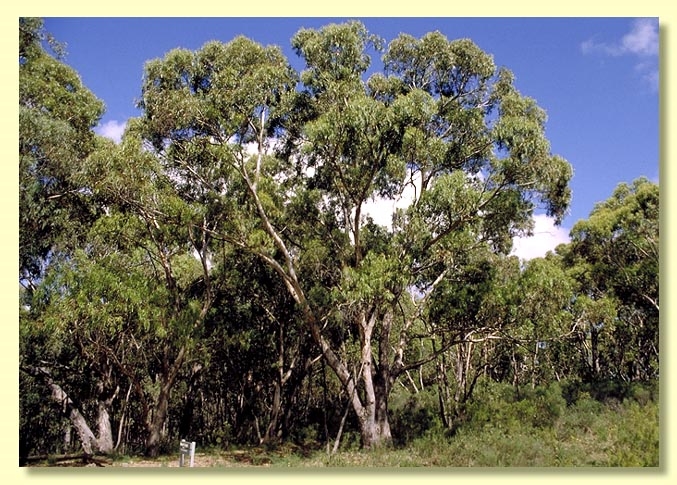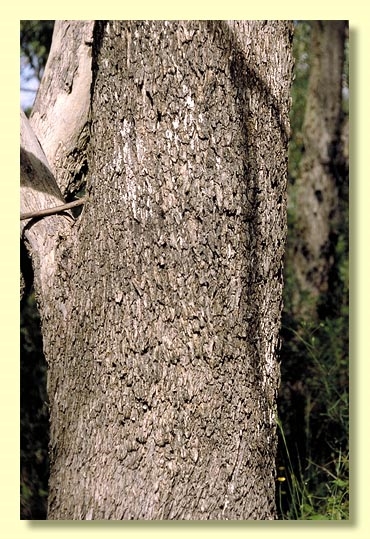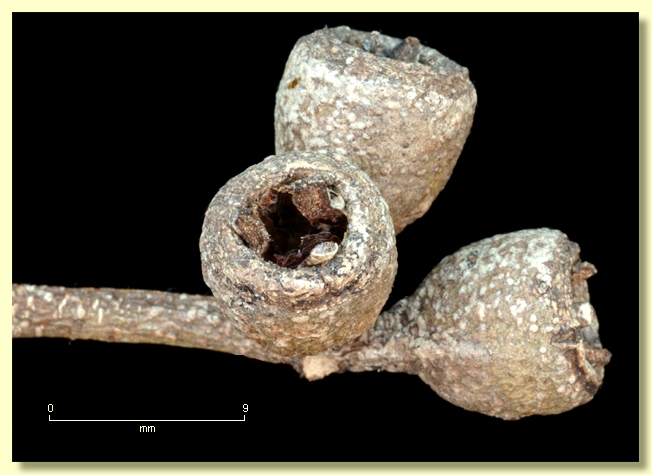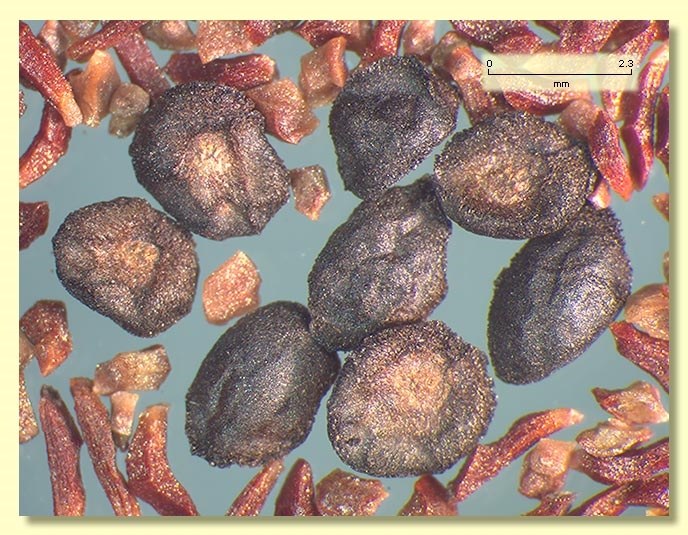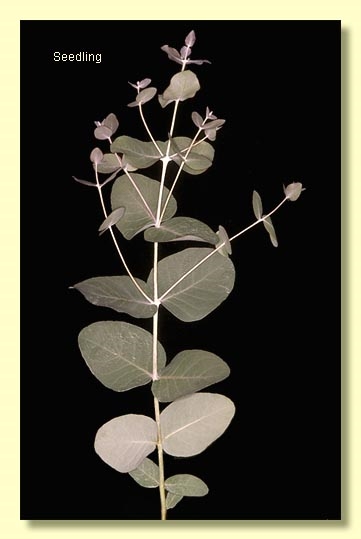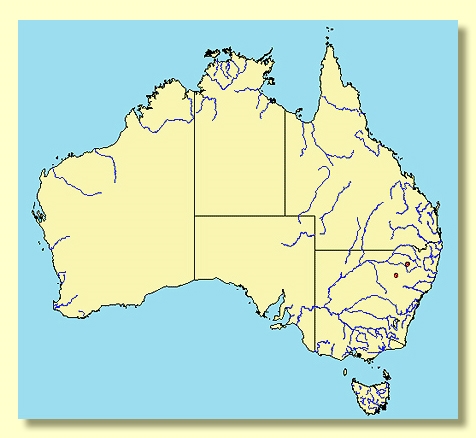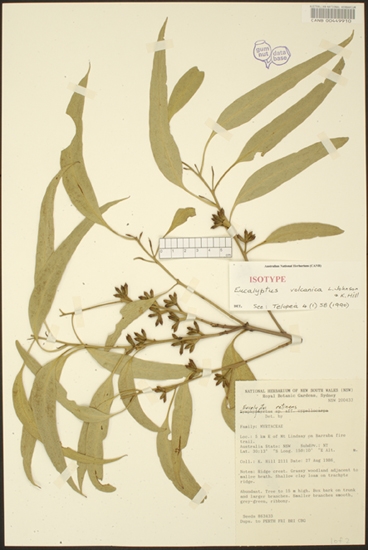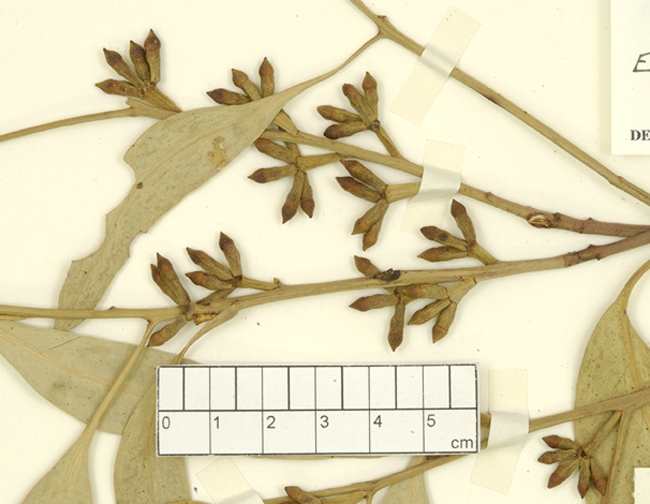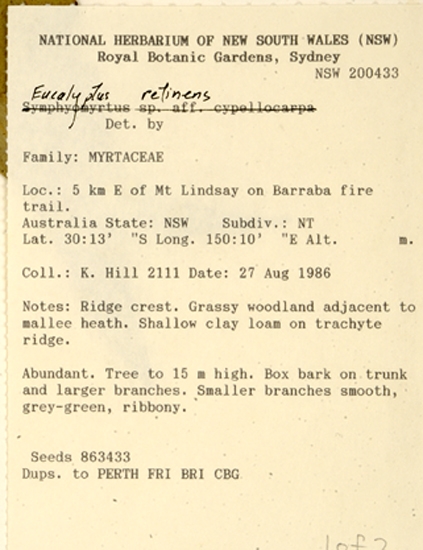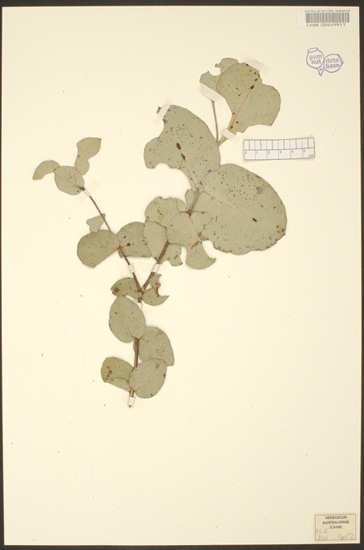Eucalyptus | Symphyomyrtus | Maidenaria | Euryotae | Globulares | Remanentes
Euclid - Online edition
Eucalyptus volcanica
T: New South Wales: Northern Tablelands: 5 km E of Mt Lindsay on Barraba fire trail, 27 Aug. 1986, K.D.Hill 2111; holo: NSW; iso: BRI, CANB, CBG, PERTH.
This taxon was referred to as Eucalyptus retinens subsp. volcanica in earlier editions of EUCLID.
Bark on trunk partly rough to fully rough, often extending to larger branches, grey, box type; smooth bark grey to green, occasionally pink to brown.
Juvenile growth (coppice or field seedlings to 50 cm): stem rounded in cross-section, smooth, juvenile leaves opposite, sessile, orbicular to ovate, 5–9 cm long, 2–7 cm wide, base rounded or amplexicaul, margin entire or sometimes crenulate, apex rounded or pointed, glaucous.
Adult leaves alternate, petioles 1.5–3.5 cm long; blade lanceolate or falcate, 10–19 cm long, 1.3–3 cm wide, flat, base tapering to petiole, margin entire, apex pointed, concolorous, glossy green, side-veins at an acute or wider angle to midrib, densely reticulate, intramarginal vein present, oil glands island.
Inflorescence axillary unbranched; peduncles broadly flattened, 0.8–1.5 cm long, buds 7 per umbel, pedicels 0.1–0.4(0.6) cm long. Mature buds cylindrical to more or less pyriform, faintly ridged longitudinally, 0.6–0.8 cm long, 0.3–0.4 cm wide, non-glaucous, scar present, stamens irregularly flexed, anthers cuboid, versatile, dehiscing by longitudinal slits (non-confluent), style long, stigma blunt, locules 3 or 4, the placentae each with 4 vertical ovule rows. Flowers white or creamy white.
Fruit on pedicels to 0.3 cm long or sessile, cup-shaped or barrel-shaped, 0.6–1 cm long, 0.6–0.9 cm wide, slightly angled longitudinally, disc raised or level or descending, valves 3 or 4, near rim level or slightly exserted.
Seeds black, 2–2.5 mm long; ovoid to flattened-ovoid, dorsal surface shallowly to deeply pitted, hilum ventral.
Cultivated seedlings (measured at ca node 10): cotyledons bilobed to oblong; stems usually square or rounded in cross-section, glaucous; leaves sessile and opposite for at least 13 nodes, orbicular to cordate, 4–7.5 cm long, 3–7 cm wide, amplexicaul or the base rounded, slightly discolorous, slightly glaucous to grey-green above and paler beneath.
Flowering time not known.
A tree of the higher parts of the Nandewar and Warrumbungle Ranges of northern New South Wales. E. volcanica is characterised by its rough, variably persistent bark, sometimes only on the lower part of the trunk, its pedicellate buds and fruit and its sessile, orbicular to ovate, glaucous juvenile leaves.
Closely related is E. retinens, a species from areas further east of E. volcanica on the Northern Tablelands of New South Wales. E. volcanica differs slightly from E. retinens by its pedicellate buds and fruit and by its glaucous juvenile leaves.
E. volcanica must also be very closely related to E. cypellocarpa of south-eastern New South Wales and eastern Victoria, which is a tall forest tree with smooth bark compared to the smaller tree with rough bark of E. volcanica. The group of species related to E. cypellocarpa need further investigation (viz. E. cypellocarpa, E. goniocalyx, E. litoralis, E. retinens, E. volcanica, E. alaticaulis, E. oresbia and E. quinniorum, the latter three species synonymised in EUCLID into E. cypellocarpa.
The occurrence of E. volcanica in the Nandewar Range is uncertain, as juvenile collections from Mt Kaputar have shown to be non-glaucous and look very similar to those of E. retinens.
Eucalyptus volcanica belongs in Eucalyptus subgenus Symphyomyrtus section Maidenaria, a large group of species more or less restricted to south-eastern Australia, characterised by bilobed cotyledons, simple axillary inflorescences, buds with two opercula, stamens with versatile anthers and flattened seeds with a ventral hilum. Within this section, E. volcanica belongs in series Globulares subseries Remanentes, having sessile, juvenile leaves opposite for many pairs, small buds in clusters of seven and small fruit.

